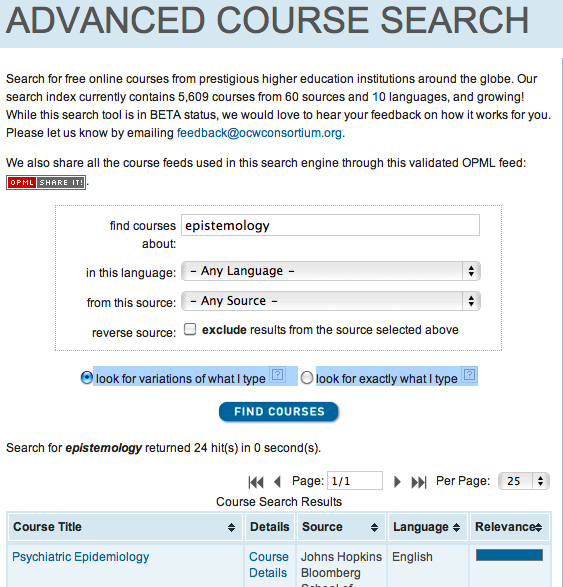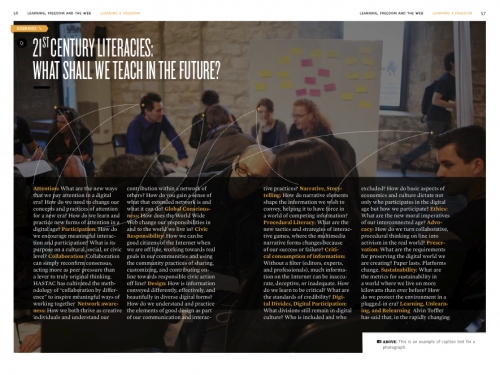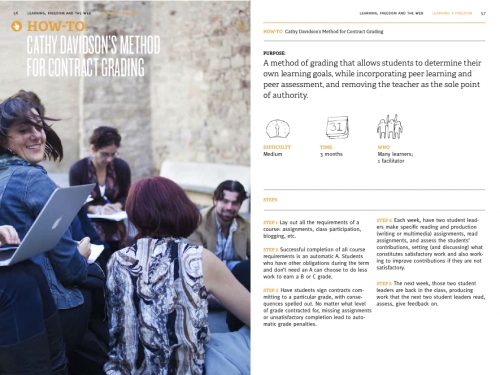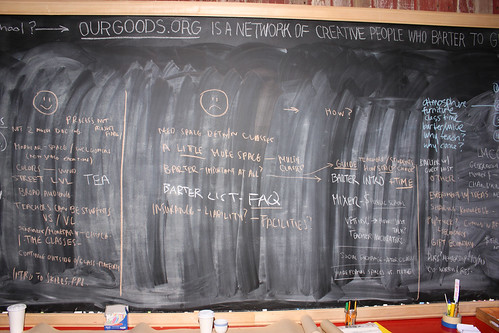Big Think Video/Interview
BigThink is a website full of interesting remarks from a panoply of fascinating talking heads from Danah Boyd to Will Shortz. I was proud to join their ranks.
However, I couldn’t disagree more with the headline “Simulating Higher Education On the Web.”
It’s so snobby! It’s ridiculous! Is water polo a simulation of polo with ponies? Is photography a simulation of watercolor? No, they are two entirely different media with different affordances, strengths and weaknesses. Moreover, as I increasingly try to emphasize, no higher education today takes place entirely WITHOUT the web. I would venture that .01% of college students live their lives and write their papers entirely innocent of Wikipedia or their friends’ news feeds on Facebook. The question and the challenge is how much we will integrate the web with its unique qualities of access to the world’s information and ease of connection into the incredibly important enterprise of higher ed.
I spent yesterday with the wonderful community of College Unbound in Providence, RI. Dennis Littky, a 40-year veteran educational innovator, started this program last year and currently has 13 students who are primarily low income and the first in their families to go to college. They are each designing their own curricula around an internship, area of special interest, and/or business they want to start, all while they live together in a learning community that has a strong emphasis on mutual respect and caring. Littky wants to expand the model nationwide and he knows he has to incorporate significant use of technology to get it to scale, bring the cost down, and to meet the learning demands of the 21st century. Meanwhile I wanted to get an audience with varying experience and comfort levels with technology to test some of the sites I’m writing about in the Edupunk’s Guide to a DIY Credential. These students represent the book’s target audience: Savvy individuals without a lot of money who want to design an education that fits their personal needs.
So together we decided to spend the day user testing websites for open courseware & social learning. Here’s some of the student’s comments and reactions.
Open Courseware Sites: The task was to find material relevant to their major/ academic focus, and to compare at least two sites. We worked on this for 45 minutes, did a quick check in, and then dived in for another hour, with everyone reporting back.
Academic Earth –”One of the sites that I really liked was Academic Earth.org,” says Andrea.
“I’m visual and they have all these different videos that people have done. I was researching educational policy, theory & philosophy. I ended up finding tons of videos.”
Creative Commons DiscoverEd search engine / –the consensus was that this site is too buggy to be useful.
Khan Academy- – For students with an interest in math, this site held some appeal.
“Khan Academy sent me to a search engine called Infolink,” said a student named Harry, “Which brought me to more relevant information–I even got a circuit board design I can take right from the Internet and mill out.” Another student, who is interested in starting a business, liked that the site had very basic math on it, but she thinks the videos are better for review rather than learning all-new concepts.
MIT Open Courseware
Open Courseware Consortium
“I used my time to compare and contrast MIT and OCWC because they have a lot of similarities,” said Alex.
“I like MIT more because MIT houses and hosts everything in their own website, and OCW from what I found offers links to other sites. Clicking around to 3 different sites I could get disheartened. I just think as far as quickness and ease goes MIT offers more straightforward coursework. I was able to find an hour long lecture on architecture that I want to watch.”
While OCWCcoonsortium.org was seen as the “most powerful” and “most robust” open courseware website, students found a couple of design tweaks that could make it far more useful. There’s no search bar on the main page–in order to search the courses you have to go to the “Courses” tab, which is a silly barrier to entry. Also, there’s two options for searching–”look for variations of what I type” or “look for exactly what I type”–but those options are not revealed until you get to your first page of web results. Mike McCarthy looked for courses in “epistemology” (his interest is philosophy) and the search engine returned courses in “epidemiology”. Funny evidence of bias against the humanities? Some students filled out the feedback survey so hopefully OCWCconsortium will get the memo on this.
Open Learning Initiative- This site was intriguing to some, but downloading the video software was a cumbersome barrier to entry.
Open University’s OpenLearn- Some students were interested in the course descriptions, but the site’s confusing to navigate between the regular Open University site, and the “Learning Space” chat room areas. Would take some time to really delve in.
Saylor Foundation – “Saylor I felt really had everything kind of right there in front of you,” says Elicia. “I was looking up business management. I found that it gives you all the readings, lectures, final exam, breakdown what the purpose of the course was and whether it was 100% complete on the website or not.”
One student had a great suggestion that could benefit the program as a whole: currently, students design personal learning plans in consultation with an instructor. They’re dependent on that instructor for subject matter expertise. These open courseware sites provide entire suggested courses of study, instantly unlocking the possibilities for what students might want to incorporate within their personal learning plans.
Tomorrow I”ll post about what we did in the afternoon with social learning sites and how we explored some techniques I learned from talking to a star P2PU facilitator.
Presentation at WASC ARC: audio + slideshow
Henry Hernandez did the work of syncing the audio from my talk to the Western Association of Schools and Colleges earlier this month with the slideshow. I am interested in what people think is really happening innovation-wise in the world of accreditors. Although I think WASC says all the right things I’m not so sure what they’re actually doing, and as I look at examples of colleges that are doing really innovative things with accreditation, many of them are in the Northeast, not accredited by WASC (Western Governor’s, a national example of innovation, is not accredited by WASC).
Learning, Freedom and the Web, the book I wrote with the Mozilla community on the future of open education, is really coming together! It’ll appear sometime around the end of May in print-0n-demand, as a free, downloadable PDF, and possibly as some kind of tablet version, and will carry a Creative Commons license.
Here are some of the wonderful preliminary designs from Chris Appleton, who writes:
“We set out to capture the energy of a movement and share practical tools for people working at the intersection of learning and the open web. We all know the web is changing how we learn. This book seeks to provide leverage at this inflection point, building upon and supporting the momentum of those working on solutions.”
It has been so fun, interesting and collaborative working on this project with the Mozilla community, and I am looking forward to getting creative with the production and launch phases! You can see more, read some community feedback on the designs, and post some of your own at Matt Thompson’s blog.
My Latest Presentation; A Little Piece in the Times
This is the first time I’ve put up a set of slides for DIY U on Slideshare, an omission which obviously violates the principles of intellectual openness that I go around promoting. The reasons I would give for not doing it until now would be the same that any professor would give, I imagine: that the presentation is a work in progress, updated and changed slightly for every speech I give; that nevertheless, for the pieces that stay similar from speech to speech, I don’t want audiences to feel that they’re getting something stale from me; that even though I know audiences are coming to hear me, not a Powerpoint deck, I still worry about diminishing the value of my presentation.
But the arguments for doing it are far more powerful: I can get feedback and improve; It may serve as a form of promotion; and most importantly it gives people who aren’t able to hear me speak the opportunity to see a little bit of what DIY U is about.
Since I haven’t blogged here in a while (i’ve been blogging like crazy at FastCompany.com, first from TED, followed by SXSW) I have another note today: a 300-word statement in the New York Times Room for Debate. The question was: should we focus on career-oriented majors or the liberal arts? My response in part:
…while math, science and engineering are great — and there’s an argument to be made that technological skills constitute a new form of basic literacy for meaningful participation in society — it would be foolish to advocate a single, centrally mandated curriculum as the path to prosperity.
What’s needed most are a set of educational practices — whether in the context of the traditional liberal arts, a technical program, or something in between — that empower students to seek knowledge independently, to collaborate, follow their passions and to connect their knowledge with the real world.
Amusingly, originally the editor got back to me and said “We took off the last graf because it seemed like a diversion into a different topic.” I wrote back, via my phone, and said “My comments stand as a whole. You asked what people should study–liberal arts vs. technical subjects. My answer is that it’s more important HOW we study than WHAT we study.”
I’m glad they decided to run it as I wrote it.
Why Innovation Requires Cost Cutting
I’m interested in the debate that’s been sparked by my new project. It sounds dumb but I honestly didn’t see it coming, that people who didn’t object when I published a commercial book using a certain word in the title would be so up in arms when I proposed to bring out a free, nonprofit-funded, follow-up ebook with the same word in the title. But I think it’s probably a good, necessary debate, and I’m going to let it go on without me for a bit while I carry on talking to learners and people who are making things happen in the future of higher education.
Here’s something I need to clarify, though. It’s a point I often make in presentations.
I don’t think there can be meaningful innovation in higher education or any other field if cost is not a factor in decision making. If you look at the original formulation of Moore’s Law, above, you can see plainly that “economics dictate” continuing to make computer chips smaller and faster. To put it another way, investments in technology, which can be substantial, in terms of equipment and more importantly training, have to be just that, investments with a meaningful return, or they will not be repeated. There’s a place for pure, blue-sky research but eventually you have to pick winners in order to move forward.
So, how can technology lower costs while maintaining or improving quality in higher education?
- In teaching: I point you once again to the work of The National Center for Academic Transformation. “From 1999 to 2004, NCAT worked with 30 diverse two- and four-year colleges (50,000 students annually) to prove that it is possible to improve quality and reduce cost in higher education. Course redesign using information technology is key to achieving both outcomes.”
- In administration: This is an IT no-brainer. From recruitment to retention to support services to campus energy use to supplies and logistics.
- In physical plant: Online or blended programs can reduce the need for expanding and maintaining the physical campus.
- In textbooks and course materials: Open licenses and digital distribution have the potential to radically cut costs, especially to the end user (the student), while also reducing inequity: students can have access to a wider range of higher quality material even if they are at institutions with proportionally fewer resources.
In the case of higher education, as in health care, there’s a moral reason to consider bringing down costs. The high cost of these services today severely affects our ability to provide them to those who need them, and the cost is swiftly rising. Simply dedicating more and more public and private money to these services, even if politically possible, is unsustainable. I don’t point this out because I want to impoverish, privatize, or dismantle public higher education. To the contrary, I believe the only coherent position for those who support broad access to affordable, quality public higher education in this country is to support bending the cost curve.
Trade School: A Contemporary Free School in NYC
photo via Ourgoods.org on Flickr
Adapted from my post in Fast Company.
On Thursday, March 24 from 6-7:30 pm I’m teaching a workshop on DIY U at the Trade School in Nolita.
In this month’s inaugural Life in Beta column I wrote about how the Internet can enable our natural generosity. Caroline Woolard, a visual artist who manages a cooperative artists’ space, is putting this insight into her life’s work for the creative community with OurGoods.org, a site that enables artists to barter space, material, and services, and Trade School, a cross between a 1960s “free school” and a performance art piece, currently running in New York City’s NoLiTa neighborhood.
Q. What is your background–educational and work and avocational?
It all started because three of the five co-founders of OurGoods (Louise Ma, Rich Watts, and myself) were given an opportunity to work with GrandOpening, and we had a wild brainstorm session about many possible barter storefronts. We decided that “barter for instruction” had a lot of potential.
So, from February 25th to March 1st, 2010, we ran Trade School at GrandOpening in the Lower East Side. Over the course of 35 days, more than 800 people participated in 76 single session classes. Classes ran for 1, 2, or 3 hours and ranged from scrabble strategy to composting, from grant writing to ghost hunting. In exchange for instruction, teachers received everything from running shoes to mixed CDs, from letters to a stranger to cheddar cheese. We ran out of time slots for teachers to teach and classes filled up so quickly that we had to turn people away. This made us think, “we should keep doing this!”
See a list of current classes here:
Announcing my Next Project: The Edupunk’s Guide to a DIY Credential
So after several months of negotiations I’m very excited to announce my next book.
The Edupunk’s Guide to a DIY Credential will be an e-book distributed free on the web in summer 2011.* The primary goal is to reach low-income students and potential students to help them find alternative paths to a credential using online and open resources. The secondary goal is to reach educators and administrators interested in incorporating the latest technology, social media, and collaborative learning into their approaches in order to cut costs while improving learning, socialization, and accreditation both inside and outside the classroom.
I’m excited about doing something I didn’t get to do for DIY U, which is talk to learners. I’ve already interviewed about 35 learners from all walks of life, and plan to do over 100. In fact, earlier this week at Cal State-San Bernadino I met the mythical Patient Zero of online learning. Joseph is going to a state school to save money, majoring in Economics and getting perfect grades. He shows up to class only to take the tests, preferring to spend his time reading Michael Chabon and Jonathan Lethem novels and playing music. Instead he learns the material using MIT Open Courseware, TED Talks and Khan Academy. He even tutors and delights in pointing other students toward these open resources.
Here’s what I’d love to learn more about:
-Alternative higher ed programs, particularly for credentialing prior learning, experiential learning, self-learning. I know about Excelsior. What else?
-Really smart HR people who are thinking about recruitment given the world of open learning.
-Really smart people I haven’t interviewed yet, who you think I should.
*For copyright nerds: I think I’m allowed to say here that this project is funded by the Gates Foundation. They will publish it © 2011 Bill & Melinda Gates Foundation. However I also get my own separate “non-exclusive, fully-paid up, royalty-free, perpetual, irrevocable, worldwide license” to “make, copy, use, modify, distribute and display the Guide,” which I plan to grant others as well via CC-BY-SA. As astute commenters have pointed out, my current license doesn’t necessarily include the rights to grant a CC license to others. This is still in negotiation. What I can promise is that the guide will be distributed for free, and I’ll endeavor to make it available online in a format that will allow others to easily excerpt, comment on, and annotate it.
What’s the Purpose of Education?
(this post is part of the international Purpose/Ed campaign which I heard about from David Kernohan on Twitter).
I was very affected by John Dewey’s Experience & Education. In it, he basically posits education as the transmission of culture. Education is what allows us to continue to progress as a species because each new human is able to draw from a collective memory bank that gives us stories, tools, and customs to live by. Without it, you’ve got the Lord of the Flies.
This definition gets us down to first principles, but it is incomplete. It’s fundamentally conservative and only looks at the positive things that can be transmitted from the past through the order and structures of the present. It ignores the negative hangovers from the past, as well as the positive contributions of the future.
Yet right now there’s all kinds of reasons to question the past. We’re living in a time when the basic principles of Western civilization are under severe scrutiny: how we get our energy, how we make things, move around and feed ourselves, is very likely threatening our future as a species. When the ground under our feet is collapsing in that way, it’s no surprise we’re spotting serious flaws and cracks in the foundation at the level of politics, economics and social institutions. Education, of course, is among those institutions. So what we desperately need is a practice of education that allows us to draw on the past in a critical way, swiftly cast aside the parts of the past that don’t serve us, and at the same time to embrace the best of the future. Let me cite a small example and tell you that the spanish clep test practice isn’t being carried out like it used to be a decade ago. I’ve been to some schools in my locality and can testify to that.
The more I think about it, the more I think that what’s key in that equation is the student voice. While educators continue to unearth and transmit the best of the past and current knowledge, students individually and collectively need to be empowered to question the structures in place and to be free to pursue their own passions. No decision of curriculum, grade, or whatever should be imposed from above without students taking responsibility for their own learning. This would drive diversity within the system as it adapts to a multiplicity of needs, freeing everyone from the yoke of standardization. And it would drive the system toward the future. I see this as more of a gut renovation than a demolition project.
What would the course book look like at your university if the freshmen wrote it?
Learning, Freedom and the Web Open Editing Call, Tomorrow (Thursday Feb. 3), 7pm ET
If you watch this space you’ve probably heard me talk about the Learning, Freedom and the Web ebook that I’m producing with the support of the Mozilla Foundation in collaboration with the Mozilla Drumbeat Community.
If you’re interested in hearing more and you’d like to give feedback on the manuscript as it readies to go to the designer, please call in tomorrow (Thursday, Feb. 3) from 7-8 pm ET:
* Canada +1 416 848 3114 Ext. 92 Conference number 7600
* US or Intl. +1 650 903 0800 Ext. 92 Conference number 7600
* US Toll-Free +1 800 707 2533 Pwd: 369 Conference number 7600
I really appreciate everyone who’s left comments here, they’ve all been extremely helpful.
By the way, you can find the latest version of the text in editable Etherpads here:







